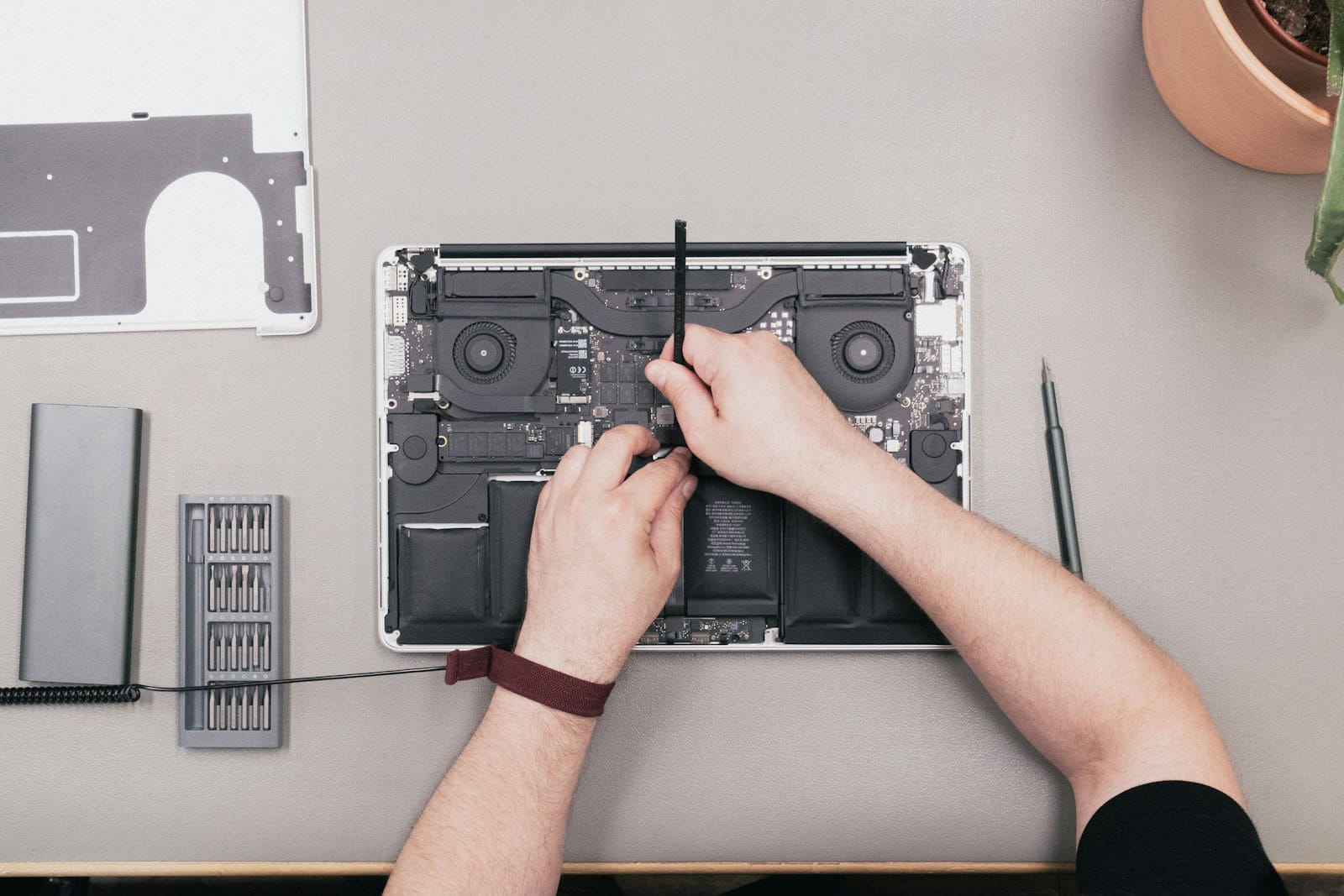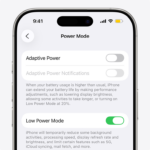Is your Mac fan making a loud noise that’s driving you crazy? Don’t worry, this is a common issue that can be fixed with a few simple steps. The quickest solution is to place your MacBook on a flat surface and give the fan more air to work with. When your Mac overheats, the fan works harder to cool it down, which causes the noise you hear.
Your Mac’s fan might be loud because the processor is working too hard, the air vent is blocked, or dust has built up in the fan. Over time, dirt and dust can collect inside your MacBook, making the fan work harder than needed. A simple cleaning might be all you need to quiet things down.
For MacBook Pro, MacBook Air, or other Mac models, you can also try resetting the System Management Controller (SMC) if you have an Intel model, or running Apple Diagnostics to check for hardware issues. These steps can help reduce fan noise and improve your Mac’s performance.
Troubleshooting Tips
A loud Mac fan usually signals your Mac is working hard to cool down its components. This can be caused by heavy CPU usage, dust buildup, software issues, or hardware problems. Follow these steps to diagnose and quiet your Mac’s fan:
1. Check for High CPU Usage
- Open Activity Monitor (Finder > Applications > Utilities).
- Look under the CPU tab for any processes consuming excessive CPU.
- Quit or force quit any unnecessary or stuck processes causing high load.
2. Restart or Sleep Your Mac
- Sometimes a simple restart or putting your Mac to sleep resets fan behavior, especially on Apple silicon Macs.
- Click the Apple menu > Restart or Sleep.
3. Close Intensive Applications
- Close apps that heavily tax your CPU or GPU, such as video editors, games, or browsers with many tabs.
4. Clean Your Mac’s Vents and Fans
- Dust can clog fans and vents, forcing fans to run louder.
- Use compressed air to gently clean vents and fans.
- If comfortable, open the back panel for deeper cleaning (for Intel Macs).
5. Update macOS and Apps
- Software updates often include fixes for bugs that may cause excessive fan use.
- Go to Apple menu > System Settings > Software Update.
6. Reset SMC (System Management Controller) on Intel Macs
- The SMC controls thermal management.
- Shut down your Mac, then follow Apple’s official procedure to reset SMC based on your Mac model.
- Note: Apple silicon Macs do not have an SMC reset option.
7. Manage Background Processes
- Disable or reduce startup items and background apps.
- Go to System Settings > Users & Groups > Login Items, and remove unnecessary apps.
8. Monitor Temperature and Fan Speeds
- Use third-party apps like iStat Menus or Macs Fan Control to monitor temps and manually control fan speeds if necessary.
9. Check for Malware or Resource-Heavy Background Tasks
- Run malware scans or check for runaway processes that might cause overheating.
10. Seek Professional Help if Needed
- Persistent loud fan noise may indicate hardware issues like failing fans or thermal paste degradation.
- Visit an Apple Store or authorized service provider.
Key Takeaways
- Place your MacBook on a flat surface and let it cool down for a few minutes.
- Clean dust from your Mac’s fan using compressed air to reduce noise.
- Run Apple Diagnostics or reset the SMC on Intel Macs to fix unexpected heavy fan use.
Understanding Mac Fan Functionality
Mac computers use cooling fans to prevent overheating and maintain optimal performance. These fans adjust their speed based on internal temperature readings and system demands.
Anatomy of Mac Fans
Mac fans are small but mighty components located strategically inside your computer. Different Mac models have different fan setups:
- MacBook Air: Usually has a single fan design
- MacBook Pro: Contains one or two fans depending on the model
- Mac Pro: Features multiple fans for enhanced cooling
The fans connect to the motherboard and receive signals from temperature sensors throughout the system. When these sensors detect heat, they trigger the fans to spin faster and push hot air out through vents in the Mac’s body.
Fan blades are designed to move air efficiently while minimizing noise. However, as Macs age, fans may collect dust or suffer wear that affects their operation.
Common Causes of Loud Fan Noises
When your Mac fan becomes noisy, several factors may be responsible. High CPU usage is a primary culprit. When running demanding apps or many programs at once, your processor works harder and generates more heat.
Blocked vents are another common issue. Using your Mac on soft surfaces like beds or couches can obstruct airflow, forcing fans to work harder.
Other causes include:
- Dust buildup inside the Mac
- Background processes consuming resources
- Outdated software or firmware
- Ambient temperature (working in hot environments)
- Hardware issues or aging components
Some users report that certain models like the MacBook Pro may have louder fans than others due to design differences or cooling needs.
Impact of Fan Noise on Mac Performance
Loud fan noise isn’t just annoying—it signals your Mac is under stress. This condition can affect your computer in several ways.
First, constant high fan speeds may indicate your Mac is regularly overheating, which can shorten component lifespan. CPUs and GPUs automatically reduce their speed (throttle) when too hot, leading to slower performance exactly when you need it most.
Battery life also suffers when fans run continuously. The cooling system draws power, and the conditions causing overheating typically drain batteries faster.
Some users try to disable features like Turbo Boost to reduce heat generation. While this may quiet fans, it also limits performance potential.
Programs like video editing software, games, or complex spreadsheets demand more processing power. Planning intensive tasks for cooler environments can help maintain both performance and acceptable noise levels.
Troubleshooting Basic Fan Issues
When your Mac fan becomes noisy, it’s usually trying to cool down your computer’s internal components. Finding the cause helps you fix the problem quickly and prevent damage to your device.
Verifying Normal Fan Operation
Mac fans naturally run at different speeds depending on what you’re doing. They speed up when your computer works harder. To check if your fan noise is normal:
- Listen for sudden changes in fan speed without heavy computer use
- Compare the sound to your Mac’s typical operation noise
- Check Activity Monitor to see if CPU usage is high when the fan is loud
Your MacBook Pro or MacBook Air might get louder when running graphics-heavy apps, video editing software, or multiple programs at once. This is normal behavior.
If your Mac fan runs loudly even when the computer isn’t doing much, there may be a problem to fix.
Checking for Software-Related Problems
High CPU usage often causes loud fans. Some apps or processes may use too much processing power, making your Mac work harder.
Open Activity Monitor (find it in Applications > Utilities) to see what’s using your CPU. Look for:
- Apps using more than 70% of CPU
- Background processes you don’t recognize
- Multiple instances of the same application
If you find problem apps, try:
- Closing unused programs
- Resetting the SMC (System Management Controller) on Intel Macs
- Restarting your Mac to clear temporary files
- Updating macOS and all applications to their latest versions
Sometimes malware can cause high CPU usage. Run a malware scan if you suspect this issue.
Inspecting for Physical Obstructions
Physical blockages prevent proper airflow and make fans work harder. Check these common issues:
Surface placement:
- Use your Mac on hard, flat surfaces
- Avoid soft surfaces like beds, pillows or blankets
- Keep at least 2 inches of space around all vents
Vent blockages:
- Look for dust buildup around vent openings
- Check if anything is blocking air intake or exhaust areas
- Make sure keyboard covers aren’t interfering with air circulation
Your MacBook needs proper ventilation to cool efficiently. Using laptop stands can help improve airflow and reduce fan noise.
Cleaning Fans and Air Vents
Dust buildup is a common cause of loud fan noise in all Mac models. Regular cleaning helps maintain proper cooling.
For external cleaning:
- Power off your Mac completely
- Use compressed air to blow dust from all vents
- Spray in short bursts, not continuously
- Hold fans still with a plastic straw or toothpick while cleaning (prevents damage)
For older MacBook Pro models where you can access internals:
- Power off and unplug your Mac
- Remove bottom case (if user-serviceable)
- Use compressed air to clean fan blades and heat sinks
For Mac Pro towers, check and clean the internal fans every 6-12 months.
Never use liquids, vacuum cleaners, or brushes directly on components. These can cause static electricity or physical damage.
Advanced Diagnostic Procedures
When simple troubleshooting doesn’t stop your Mac’s loud fan, you’ll need deeper analysis tools to identify the exact cause. These procedures help pinpoint whether software processes, temperature issues, or hardware failures are making your fan work overtime.
Utilizing Activity Monitor for CPU Usage
Activity Monitor is a powerful tool for tracking down resource-hungry apps that might be overworking your MacBook’s fan. To access it, open Finder, go to Applications > Utilities > Activity Monitor.
Look at the CPU tab and sort by “% CPU” to see which apps are using the most processing power. Programs using more than 70% CPU for extended periods often cause fan noise.
Steps to identify problem applications:
- Open Activity Monitor
- Click the CPU column to sort by highest usage
- Watch for apps consistently using high CPU
- Quit unnecessary high-resource applications
Sometimes background processes can be the culprit. Check for processes you don’t recognize that use high CPU. Resetting the System Management Controller (SMC) can help normalize your Mac’s fan behavior if software isn’t the issue.
Determining If Overheating is Occurring
Your MacBook fan works harder when internal temperatures rise. Poor air circulation is often the cause of persistent fan noise.
Temperature checking options:
- Install temperature monitoring apps like Macs Fan Control or TG Pro
- Check if specific areas of your MacBook feel unusually hot
- Note if fan noise increases when using graphic-intensive applications
Make sure your Mac’s air vents aren’t blocked. Using your MacBook on soft surfaces like beds or couches can block airflow and cause overheating. Always use your device on hard, flat surfaces.
Check your Mac’s environment too. Room temperatures above 80°F/27°C can make your Mac run hotter than normal, triggering the fan to work harder.
Assessing Hardware Health
Sometimes loud fan noise indicates hardware problems, especially in older MacBooks. Dust buildup inside your Mac is a common culprit that restricts airflow and forces fans to work harder.
Hardware assessment checklist:
- Run Apple Diagnostics to check for hardware issues
- Inspect for dust buildup in vents
- Check if fan noise started after a recent drop or impact
- Note if fan behavior changed after a system update
To run Apple Diagnostics, shut down your MacBook, then restart while holding the D key. Follow the onscreen instructions to complete the test.
If your MacBook is older (4+ years), the thermal paste between the processor and heatsink might be dried out. This prevents proper heat transfer and causes fans to run constantly. Professional servicing may be needed to apply fresh thermal paste.
Professional Support and Repairs
When your Mac’s fan noise becomes a persistent problem, seeking expert help might be your best option. Professional technicians have the tools and knowledge to diagnose complex issues that may be causing your fan to run loudly.
When to Contact Apple Support
If your Mac fan continues to make excessive noise after trying basic troubleshooting, it’s time to contact Apple Support. They offer several ways to get help:
- Online chat support
- Phone support
- Email support
- Support through the Apple Support app
Apple’s support team can run remote diagnostics to check if your fan is working properly. This is especially helpful for identifying temperature sensor issues that often cause fans to run at high speed.
For MacBook Pro and MacBook Air models, Apple may already know about common fan problems with your specific model. They can tell you if your device qualifies for a repair program that covers known issues.
Visiting an Apple Store for Service
Taking your Mac to an Apple Store gives you access to hands-on expert help. Before your visit:
- Back up your data
- Bring your proof of purchase
- Make an appointment with the Genius Bar
The Apple technician will likely run Apple Diagnostics to identify hardware problems. This test can find issues with the cooling system, including faulty fans or thermal sensors.
Repair costs vary based on your warranty status. AppleCare+ coverage can save you money on fan replacements and related repairs. For older MacBook models, be prepared for potential longer wait times as parts may need to be ordered.
Exploring Third-Party Repair Options
If your Mac is older or you prefer alternatives to Apple’s service, third-party repair shops can help. Look for shops that:
- Specialize in Mac repairs
- Have certified technicians
- Offer warranties on their work
- Use genuine or high-quality replacement parts
Many reputable repair services can fix fan issues at lower costs than Apple. Some even offer same-day service for simple fan replacements.
For Mac Pro desktop models, third-party options might be particularly valuable as these systems are highly modular. Specialized repair shops often have experience dealing with the unique cooling systems in these professional-grade computers.
Online services like JustAnswer connect you with Mac experts who can guide you through troubleshooting steps before you commit to a repair.
Optimizing Mac for Better Performance
Keeping your Mac running smoothly requires a combination of regular maintenance, smart system settings, and sometimes hardware upgrades. These steps can significantly reduce fan noise while improving overall performance.
Regular Maintenance Tips
Dust buildup is a common cause of loud fans on MacBooks. Clean your Mac’s vents every 3-6 months using compressed air. Hold the can upright and spray in short bursts to avoid moisture damage.
Check for resource-heavy applications regularly. Open Activity Monitor to identify apps using excessive CPU. Force quit any unnecessary programs running in the background.
Clear cache files periodically. Go to Finder > Go > Go to Folder and type ~/Library/Caches. Delete files from apps you don’t use regularly.
Restart your Mac at least once a week. This clears RAM and temporary files that might cause your system to work harder than necessary.
Keep your desktop clean. Many files on your desktop can slow down your MacBook and make fans work harder.
Software and System Settings for Optimal Fan Usage
Enable Low Power Mode to reduce fan noise. Go to System Settings > Battery > Low Power Mode and select “Always” or “Only on Battery” to lower energy consumption.
Update macOS regularly. Apple often releases performance improvements that help manage temperature and fan speed. Check for updates in System Settings > General > Software Update.
Adjust Energy Saver settings. Lower screen brightness and set your display to sleep after 5 minutes of inactivity.
Monitor CPU-intensive applications like Photoshop. Consider using lighter alternatives when possible, or quit these programs when not in use.
Use Activity Monitor to check which apps are using the most resources. Sort by “% CPU” to find the culprits making your fan work overtime.
Upgrading Hardware for Enhanced Efficiency
Replace your old hard drive with an SSD. This upgrade dramatically improves performance on older MacBook Pro and MacBook Air models, reducing the strain that causes fan noise.
Upgrade RAM if possible. More memory allows your Mac to handle multiple tasks without overheating. Check your model’s specifications to see if RAM is upgradeable.
Consider thermal paste replacement for older Macs. Over time, thermal paste between the CPU and heat sink degrades. Professional replacement can improve heat transfer.
Clean the internal components if you’re comfortable opening your Mac. Dust builds up inside and blocks airflow, making fans work harder.
Note: Hardware upgrades may void your warranty. Check Apple’s policies or consult an authorized service provider before making changes.
Using External Tools and Accessories
Cooling pads provide extra airflow for MacBooks. Models with built-in fans can significantly reduce operating temperatures during intensive tasks like video editing or gaming.
Laptop stands improve air circulation by elevating your device. Always use your Mac on a hard, flat surface—never on soft surfaces like beds or couches.
Third-party fan control software can help manage temperatures. Apps like Mac Fan Control let you set custom fan speeds based on temperature thresholds.
External GPUs can offload graphics processing from your MacBook Pro, reducing heat generation during intensive tasks.
Monitor room temperature. Keep your workspace cool, ideally between 50-95°F (10-35°C), as Macs run more efficiently in cooler environments.
Frequently Asked Questions
Mac fans can become loud for several reasons including dust buildup, high CPU usage, or outdated software. Here are answers to common questions about troubleshooting and fixing noisy Mac fans.
Why does my MacBook Air fan produce excessive noise abruptly?
Your MacBook Air fan might suddenly become loud when running intensive applications that increase CPU usage. This causes your Mac to heat up quickly, making the fan work harder to cool it down.
Software issues can also trigger fan noise. Background processes may be using too much processing power without your knowledge.
A system management controller (SMC) reset often fixes unexpected fan behavior on Intel-based Macs. For Apple silicon Macs, try restarting your computer instead.
What steps can I take to troubleshoot a loud fan noise on my MacBook Pro?
First, check which apps are using the most CPU. Open Activity Monitor and look at the CPU tab to find resource-hungry applications. Close any apps you don’t need.
Make sure your MacBook Pro has proper ventilation by using it on a hard, flat surface. Soft surfaces like beds or couches can block air vents.
Run Apple Diagnostics to check for hardware problems. Restart your Mac and hold the D key during startup to access this tool.
How can a dirty MacBook fan be cleaned to reduce noise levels?
Turn off your Mac completely before cleaning. Use compressed air to blow dust out through the vents in short, controlled bursts. Hold the can upright to avoid spraying liquid into your Mac.
For deeper cleaning, you may need to open your Mac. This is best done by a professional unless you have experience with computer hardware.
Regular cleaning every 3-6 months helps prevent dust buildup that makes fans work harder and create more noise.
What might cause a MacBook fan to become loud while also experiencing rapid battery depletion?
A program running in the background could be using excessive CPU power, causing both issues. Check Activity Monitor to identify these resource-hungry processes.
Malware can sometimes cause this dual problem. Run a malware scan with a trusted security tool to check for unwanted software.
Battery health issues might force your Mac to work harder, heating up and activating the fan. Check your battery health in System Settings under Battery > Health.
How can I manage my Mac’s fan speed to decrease loud operational sounds?
Third-party apps like Macs Fan Control let you adjust fan behavior. These tools can set custom fan speeds based on temperature thresholds.
Be cautious when manually lowering fan speeds, as this might cause your Mac to overheat. Never set speeds too low when running demanding tasks.
Apple’s built-in settings don’t offer direct fan control, but updating macOS can improve thermal management and reduce unnecessary fan activity.
What are the potential reasons for a MacBook overheating and causing the fan to become noisy?
High ambient temperature makes cooling more difficult. Try working in cooler environments when possible.
Running multiple intensive applications at once creates more heat than your Mac can disperse efficiently. Close apps you’re not using.
Blocked vents prevent proper airflow. Check that nothing is covering your Mac’s ventilation openings, especially near the hinge area on MacBooks.
Aging thermal paste between the processor and heat sink can reduce cooling efficiency. Professional replacement every few years may help older Macs run cooler.







